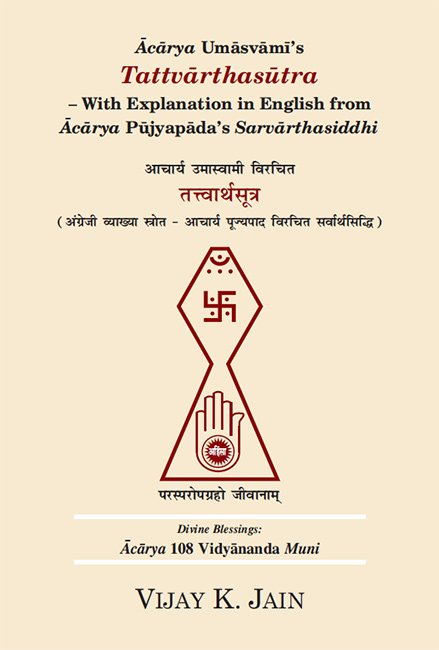Tattvartha Sutra (with commentary)
by Vijay K. Jain | 2018 | 130,587 words | ISBN-10: 8193272625 | ISBN-13: 9788193272626
This page describes the characteristics of matter (pudgala-lakshana) which is verse 5.23 of the English translation of the Tattvartha Sutra which represents the essentials of Jainism and Jain dharma and deals with the basics on Karma, Cosmology, Ethics, Celestial beings and Liberation. The Tattvarthasutra is authorative among both Digambara and Shvetambara. This is verse 23 of the chapter The Non-living Substances and includes an extensive commentary.
Verse 5.23 - The characteristics of matter (pudgala-lakṣaṇa)
Sanskrit text, Unicode transliteration and English translation of Tattvartha sūtra 5.23:
स्पर्शरसगन्धवर्णवन्तः पुद्गलाः ॥ ५.२३ ॥
sparśarasagandhavarṇavantaḥ pudgalāḥ || 5.23 ||
The forms of matter (pudgala) are characterized by touch (sparśa), taste (rasa), smell (gandha) and colour (varṇa). (23)
Hindi Anvayarth:
अन्वयार्थ: [स्पर्श रस गन्ध वर्णवन्तः] स्पर्श, रस, गन्ध और वर्ण वाले [पुद्गलाः] पुद्गल द्रव्य हैं।
Anvayartha: [sparsha rasa gandha varnavantah] sparsha, rasa, gandha aura varna vale [pudgalah] pudgala dravya haim |
Explanation in English from Ācārya Pūjyapāda’s Sarvārthasiddhi:
What are the special marks (lakṣaṇa) of the matter (pudgala)?
What is touched or touching alone is touch (sparśa). It is of eight kinds, namely, soft (komala), hard (kaṭhora), heavy (bhārī), light (halkā), cold (ṭhańḍā), hot (garma), smooth (snigdha) and rough (rūkṣa). What is tasted or tasting alone is taste (rasa). It is of five kinds: bitter (tītā), sour (khaṭṭā), acidic (kaḍuā), sweet (mīṭhā) and astringent (kasailā). What is smelt or smelling alone is smell (gandha). It is of two kinds: pleasant smell (sugandha) and unpleasant smell (durgandha). Colour is of five kinds: black (kālā), blue (nīlā), yellow (pīlā), white (safeda) and red (lāla). The foregoing are the principal divisions. And the subdivisions of each of these may be numerable (saṃkhyāta), innumerable (asaṃkhyāta) and infinite (ananta). These–touch, taste, smell and colour–are always associated with the matter (pudgala). For instance, we speak of the (Indian) fig tree possessing milky juice. A question is raised. In sūtra 5-5, it has been said, ‘Things which have form–rūpī–constitute the matter (pudgala).’ And, it has been explained that form (colour) includes taste, smell and touch also. Thus the characteristics of the matter have already been established. This sūtra, therefore, is unnecessary. But this is untenable. Sūtra 5-4 says, ‘The substances (dravya) are eternal (nitya), fixed-in-number (avasthita) and colourless (arūpī)’. That would imply that matter also is non-material–arūpī–like the rest. Sūtra 5-5 was intended to exclude that view. The present sūtra is intended to explain the distinctive characteristics of the forms of matter (pudgala).
